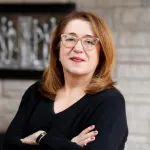The study, published today (5 February 2021) in Science Advances, sought to understand why neuroblastomas range in severity, with some easy to treat and others having relatively low five-year survival rates. The fact that all neuroblastomas arise from sympathoblasts makes them an attractive drug target, because these cells exist only in the tumour after the child is born.
Neuroblastoma is a rare cancer that generally affects children under five years old. It begins in the abdomen, usually in the adrenal glands - hormone-producing glands above the kidneys. Neuroblastoma is remarkable in that its severity can vary greatly between individuals. In some children the cancer will disappear without treatment, whereas in others the cancer is relentless. The five-year survival rate for neuroblastoma is one of the lowest of all childhood cancers*.
This varied outlook prompted the researchers to ask whether the range of severity could be caused by neuroblastomas arising from different cell types at different stages of the child's development in the womb. This was made possible by the advent of single cell mRNA sequencing, a high-resolution technology that can identify different cell types present in a tissue according to the genes expressed by individual cells.
In this study, gene expression of 19,723 cancer cells was analysed and compared to a reference of 57,972 developmental adrenal cells in the hope of identifying the cell types from which neuroblastomas arise and to find novel treatment targets.
Dr Jan Molenaar, a senior author of the study from the Princess Máxima Center for Pediatric Oncology in the Netherlands, said: "What is most striking about our findings is that despite the great diversity of clinical behaviour of neuroblastoma, there is an overarching neuroblastoma cell type that is found in all patients. The identification of sympathoblasts as the root of all neuroblastoma is an important step towards understanding how the disease develops and, hopefully, how we can treat it."
Currently, many cancer treatments cause serious side effects for the patient. But in recent years, technological advances have sped up drug development by allowing researchers to identify differences between the biological processes, such as the expression of a particular gene, within healthy human cells and those within cancerous ones. These differences can be exploited to attack cancer cells without affecting the patient's healthy cells.
The presence of sympathoblasts, a developmental cell type not normally found in children after they are born, makes it a promising drug target for the treatment of neuroblastoma.
Dr Karin Straathof, a senior author of the study from Great Ormond Street Hospital, said: "Neuroblastoma is an unusual cancer in that some tumours resolve without intervention, yet the disease still has one of the lowest five-year survival rates of any childhood cancer. This study fills important gaps in our knowledge of what neuroblastoma cells are and revealed novel treatment targets. My hope is that new, less intrusive therapies can be developed by targeting sympathoblasts, a developmental cell type that exists only in neuroblastoma tumours after a child is born."
As well as facilitating the discovery of sympathoblasts as the root of neuroblastoma, the single-cell reference map of the developmental adrenal gland will also contribute to the Human Cell Atlas project**. The project aims to create comprehensive reference maps of all types of human cells - the fundamental units of life - as a basis for understanding human health and diagnosing, monitoring, and treating disease.
Dr Sam Behjati, a senior author of the study from the Wellcome Sanger Institute and Cambridge University Hospitals, said: "Our study shows the power of looking at individual childhood cancer cells in revealing not just one, but a plethora of novel treatment ideas. This raises the exciting prospect that a single cell atlas of all types of paediatric tumours may transform our understanding of childhood cancer."
INFORMATION:
Contact details:
Dr Matthew Midgley
Press Office
Wellcome Sanger Institute
Cambridge, CB10 1SA
Phone: 01223 494856
Email: press.office@sanger.ac.uk
Notes to Editors:
*More information on neuroblastoma is available from Cancer Research UK:
https://www.cancerresearchuk.org/about-cancer/childrens-cancer/neuroblastoma/about
**More information about the Human Cell Atlas (HCA) project is available here:
https://www.humancellatlas.org/
Publication:
Gerda Kildisiute, Waleed M. Kholosy, Matthew D. Young et al. (2021). Tumor to normal single-cell mRNA comparisons reveal a pan-neuroblastoma cancer cell. Science Advances. DOI: https://doi.org/10.1126/sciadv.abd3311
Funding:
This study was funded by Wellcome. Additional funding was received from the St Baldrick's Foundation and the National Institute for Health Research (NIHR).
Selected websites:
About the Princess Máxima Center
Every year some 600 children in the Netherlands are diagnosed with cancer. One in four children with cancer still dies from the disease.
In order to cure children from cancer, all care and research in the Netherlands is concentrated in the Princess Máxima Center for pediatric oncology in Utrecht. More than ten years ago, parents and healthcare professionals took the initiative. The new pediatric oncology center was opened by Queen Máxima of the Netherlands on 5 June 2018.
The mission of the Princess Máxima Center is to cure every child with cancer, with optimal quality of life. The Princess Máxima Center is the largest pediatric oncology center in Europe where care and research are closely intertwined. Approximately 400 scientists and more than 800 healthcare professionals work closely together.
About Research at Great Ormond Street Hospital
Great Ormond Street Hospital is one of the world's leading children's hospitals with the broadest range of dedicated, children's healthcare specialists under one roof in the UK. The hospital's pioneering research and treatment gives hope to children from across the UK with the rarest, most complex and often life-threatening conditions. All research at Great Ormond Street Hospital NHS Foundation Trust and UCL Great Ormond Street Institute of Child Health is made possible by the NIHR Great Ormond Street Hospital Biomedical Research Centre.
The Wellcome Sanger Institute
The Wellcome Sanger Institute is a world leading genomics research centre. We undertake large-scale research that forms the foundations of knowledge in biology and medicine. We are open and collaborative; our data, results, tools and technologies are shared across the globe to advance science. Our ambition is vast - we take on projects that are not possible anywhere else. We use the power of genome sequencing to understand and harness the information in DNA. Funded by Wellcome, we have the freedom and support to push the boundaries of genomics. Our findings are used to improve health and to understand life on Earth. Find out more at http://www.sanger.ac.uk or follow us on Twitter, Facebook, LinkedIn and on our Blog.
About Wellcome
Wellcome exists to improve health by helping great ideas to thrive. We support researchers, we take on big health challenges, we campaign for better science, and we help everyone get involved with science and health research. We are a politically and financially independent foundation.
https://wellcome.org/




